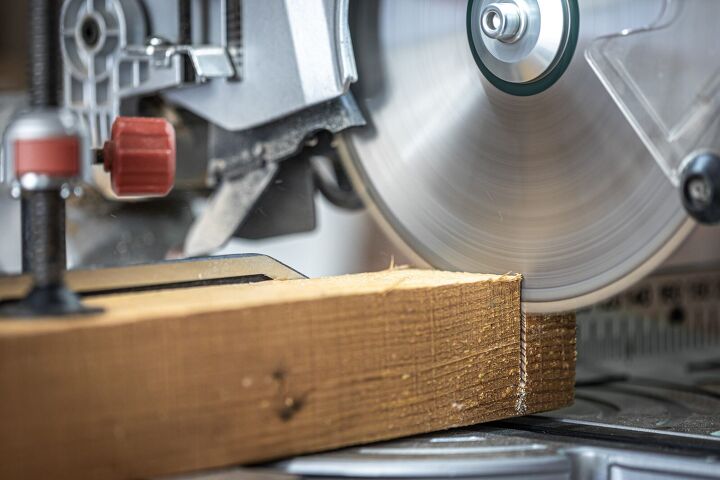Dual-Bevel Vs. Single-Bevel Miter Saw: What Are The Major Differences?

If you do a lot of woodworking or DIY projects, you might already have a miter saw. Miter saws make it easy to create angled cuts for things like trim, crown molding, door frames, baseboards, and even picture frames. But when it comes to a dual-bevel vs single-bevel miter saw, is one better than the other?
The primary difference between a single-bevel and dual-bevel miter saw is the orientation of the cut. A single saw only cuts bevels in one direction, so you need to reposition your workpiece to cut the other way. But a double-bevel miter saw swivels, making it possible to cut to the right or left without moving things around.
If you’re ready to add a miter saw to your arsenal of tools, know the pros and cons of single and dual-bevel models. Depending on your needs and budget, you might determine one will work better for you than the other.
Closer Look At Single-Bevel Miter Saws
A single-bevel miter saw cuts both miter and bevel cuts but only does so from one side. Most single-bevel saws cut to the left, but others cut to the right. You can still accomplish the same tasks you can with a dual-bevel, but it will take more time and effort.
Single-bevel saws can undoubtedly get the job done but take into consideration that your tasks will take a bit longer. This could be an excellent saw for you unless you’re planning to cut a lot of crown molding or trim. Here’s a closer look at the pros and cons of single-bevel miter saws.
Pros Of Single-Bevel Miter Saws
- Less Expensive — Due to their more straightforward design, single-bevel miter saws are less expensive than double-bevel. Depending on the brand and blade size, you can find single-bevel saws as low as $100. However, the average is about $150 to $250.
- Simple to Use — Since they only cut in one direction, single-bevel miter saws are simpler to use. You won’t have as many things to figure out, so it’s also a good saw for a beginner.
- Less Maintenance — It’s essential to properly maintain any tool, and the more moving parts, the more complex maintenance. When it comes to miter saws, compressed air works well to get rid of dust and debris. Since there are fewer moving parts on a single bevel, it’s easier to maintain and keep clean.
Cons
- Harder to Make Uniform Cuts — You will have to try harder to make uniform cuts with a single-bevel saw. This is because you must reposition your workpiece every time you cut from the other direction. The more you move things around, the more difficult to achieve precise cuts.
- Work Takes Longer — Also, since you need to move around your workpiece, it adds time to the overall project. So most things you do with a single-bevel will end up taking you longer than it would with a dual-bevel saw.
- Fewer Features — The more straightforward operation comes at a cost — fewer capabilities. If you want a saw that does more and can handle heavier workloads, this wouldn’t be the best fit for you.
Closer Look At Double-Bevel Miter Saws
Double-bevel miter saws also cut miter and bevel cuts, but they can do some from the right and the left. Therefore, you can make cuts on both sides of your workpiece without having to reposition anything.
If you’re a contractor, carpenter, professional builder, or diehard DIYer, you’d likely prefer this type of saw. Here’s a closer look at the pros and cons of double-bevel miter saws.
Pros
- Finish Projects Faster– You don’t need to move things around whenever you need to make a different cut. Therefore, you’ll finish things faster.
- Allows You to Do More Work — Dual-bevel saws are excellent for contractors and pro builders because you can do more. Since you can finish tasks faster, you can take on more projects. This also leads to making more money if you do woodworking as a job or career.
- Make Uniform Cuts — The other benefit of cutting from either direction without moving your workpiece is uniformity. You’ll achieve more precise, uniform cuts since you can work on both sides of your item without moving it or the saw.
Cons
- More Involved Operation — Dual-bevel miter saws have more features, which means there’s more to learn. If you’re a beginner, you might have more of a learning curve to tackle.
- Costs More — All of the additional capabilities mean dual-bevel miter saws cost more. You’d likely spend between $200 to $400. You can expect, on average, that they will cost at least $100 more than their single-bevel counterpart.
Fixed Miter Saws vs. Sliding Miter Saws
In addition to single-bevel or dual-bevel, you’ll also see fixed and sliding styles of miter saws. You can find both single and dua-bevel saws in fixed or sliding models.
Sliding models typically allow you to cut wider boards since they slide, and they usually cost a little more too. You can expect to pay between $75 and $100 more for a sliding saw compared to a comparable fixed model.
Again, a fixed saw will likely be sufficient if you’re just doing basic jobs. But a sliding design could be better if you have many woodworking projects, are a contractor, or work with larger boards.
Is A Double-Bevel Miter Saw Worth It?
A double-bevel miter saw could be worth the extra money if you do a lot of woodwork that requires angled and specialized bevel cuts. Since you don’t have to reposition the saw to make cuts from the opposite orientation, it can potentially save you a lot of time.
Since a dual-bevel saw allows you to make more precise cuts over and over, it can shave a lot of time off a large project. Overall, this can make you more efficient and enable you to accomplish more jobs in a shorter period.
For these reasons, a dual-bevel miter saw is a good investment for contractors, professional carpenters, and dedicated hobbyists and DIYers. However, a dual-bevel saw’s additional cost and complexity are likely unnecessary if you only engage in occasional woodworking projects.
Instead, you would appreciate the more straightforward operation and lower expense of a single-bevel saw. Therefore, consider what types of projects you do and how often you would use your saw when making your choice.
Is A Compound Miter Saw The Same As A Dual-Bevel?
Both single and dual-bevel saws are compound miter saws. A compound miter saw refers to a saw that makes both miter and bevel cuts.
A regular miter saw cuts angles other than 90 degrees using a vertical blade. However, a bevel cut is a more specialized miter cut, and not all miter saws make them.
You make a bevel cut when you can tilt the blade of your miter saw. So, you can position the blade at the appropriate angle and, in addition, tilt it to cut the angle on a bevel. Consequently, miter saws that can also perform bevel cuts are known as compound miter saws.
Summary
If you’re into building, woodworking projects, and similar tasks, whether as a hobbyist or pro, you could benefit from a miter saw. For basic and occasional jobs, a single-bevel is all you need. It’s easier to operate and maintain, and it typically costs less.
Single-bevel saws make miter and bevel cuts, but they only do so from one direction. Therefore, you’d need to reposition your workpiece to make a cut from a different orientation. This can add time to your project but might not be a big deal if you don’t need to do it often.
However, if you’re a contractor or dedicated hobbyist with lots of projects, efficiency is a priority. A double-bevel miter saw allows you to make miter and bevel cuts from the right and the left. This can save you a ton of time, but it does come at the cost of about $100 more.
Double-bevel saws are also a bit more involved and require a little more maintenance. However, you can get more done since you don’t have to move things around for every cut. So, if you’re a pro, a faster work time means more jobs, which means more money.

Stacy Randall is a wife, mother, and freelance writer from NOLA that has always had a love for DIY projects, home organization, and making spaces beautiful. Together with her husband, she has been spending the last several years lovingly renovating her grandparent's former home, making it their own and learning a lot about life along the way.
More by Stacy Randall












![The 5 Best Angle Grinders – [2022 Reviews & Buyer's Guide]](https://cdn-fastly.upgradedhome.com/media/2023/07/31/9071326/the-5-best-angle-grinders-2022-reviews-buyer-s-guide.jpg?size=350x220)














